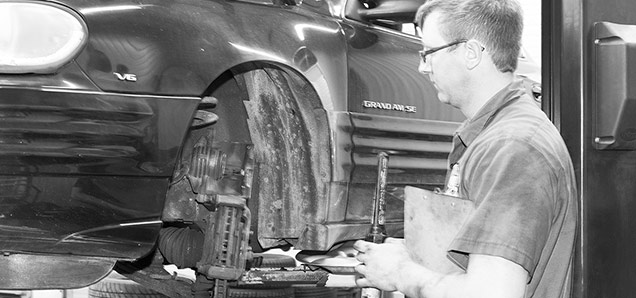What to get your car for Christmas
 CREDIT: MICHAEL BARRETT
CREDIT: MICHAEL BARRETTA mechanic at Auto Guys explains a tie rod issue discovered during inspection. Taking your car in for a winter checkup could go a long way in preventing cold-weather accidents.
With many Fanshawe students planning to drive home for the holidays, a small investment in automotive maintenance could prevent a missed trip, avoid an expensive breakdown, or save a life.
According to statistics published by Allstate Canada, the highest percentage of fatal and non-fatal auto collisions occurs in January, with weather and road conditions playing a major factor. Allstate's website says, “Keeping your car in good condition will help to keep it safe.” Major parts to look at are tires, breaks, battery and exhaust, and some frequently overlooked items are windshield wipers, fluid levels, lights and hoses.
Many vehicle owners find the best solution is a trip to a trusted professional. A winter maintenance package can cost between $45 and $90. It should include an oil change, full inspection and rotating or changing the tires. This takes about 45 minutes.
Winter maintenance might even save you money. Bob Ward of Auto Guys in St. Thomas said, “A car that is regularly maintained [in the summer or winter] will outlast a car that is not maintained. It will cost you less in breakdowns and it will save you far more fuel because it is in good repair. It doesn't leak oil and [its maintenance record] also adds to the resale value.”
Experts and authorities are in agreement: winter tires reduce collisions and save lives. For instance, the Ministry of Transportation of Ontario as well as Transport Canada recommend winter tires, and Wheels.ca cites Germany's 50 per cent drop in automotive personal injuries, upon making winter tires mandatory, as proof of effectiveness.
“A lot of people think that all-season tires can do a good job in winter — they don't,” Ward said. “Unless the tire bears the snowflake emblem on it, when it gets down to about zero degrees� the rubber compound gets so hard it loses its traction qualities.” This means you can lose control over your acceleration, steering and brakes. Ward added that winter tire sales are on the rise because more people are recognizing their value.
An increasing number of insurance companies offer discounts to motorists who make the switch, and in some cases failing to have winter tires may affect the determination of degree of fault after a collision.
The only caveat to the argument for winter tires — or any safety improvement — is the potential for carelessness if the motorist drives differently because he or she “feels” safer (an effect witnessed upon the transition to both mandatory seatbelts and airbags). Nonetheless, winter tires are a statistically verified improvement; it is up to the driver to make sure that all other safety factors remain in check.
After having winter tires installed, the next step is ensuring they are properly inflated. According to Transport Canada, “A tire that has good pressure when checked in a warm garage will be under-inflated when it is below zero outside — because tire pressure goes down in the cold. That is why you should do your checks when the tires are cold.”
Transport Canada's website also states that winter tires should match. Though some experts dispute the need for all four to match, it is preferable (particularly for all-wheel drive vehicles), but is essential that wheels on the same axle be identical. Furthermore, the MTO website states, “If using only two winter tires, regardless of whether the vehicle is front-, rear- or all-wheel drive, these should be installed on the rear axle for best vehicle stability in turns and during braking.”
More tips can be found in the “Winter Driving: Be Prepared, Be Safe” brochure, which can be found for download through tinyurl.com/ontariodrivesafe.
WHAT TO KEEP IN YOUR CAR THIS WINTER
- Cellphone
- Blankets and spare clothing/footwear
- Windshield Washer fluid and antifreeze
- A shovel, brush and scraper
- Sand/kitty litter for traction if stuck
- Booster cables
- Emergency food
- Survival candle, such as “Candle in a Can”
- Flashlight and/or emergency flares
- First-aid kit













